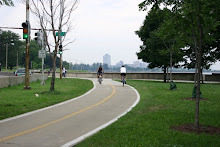it clacks its fierce metallic teeth and charges at students, clicking its gears menacingly
The University would be wise to [...] impose regulations upon the well-armed hooligans who circle our campus astride their potent death machines, forever in search of speed and the blood of innocents.
The article is a fine example of hysterical alarmism; it is hardly possible to take this overblown caricature seriously, let alone relate to it. A balanced presentation would have served Ms McNear's cause better.
Style considerations aside, the Maroon is right in pointing out the rude behavior of cyclists. (I am the first one to admit not respecting all traffic rules, although I don't ride on campus.) The problem lies in the "special" status of bikers: they're not pedestrians, but they're not accountable for respecting traffic laws either (or at least not forced to).
The solution is not "requiring cyclists to obtain licenses," as Ms McNear says. Who are we kidding? What difference is it gonna make to pass a test? And how much money would it cost the University to "train" the hundreds of bike users that join the neighborhood every year, as well as to administer the system?
The only things that would change the behavior of cyclists would be:
(a) Setting clear rules of where and how cyclists and pedestrians can share the campus roads and sideways. For example, are bikes supposed to use pedestrian crossings? Are they supposed to ride on the quads? Which areas are off limits for bikes? And so on.
(b) Enforcing those rules, as well as the regular traffic rules (does any day pass without seeing a biker going the wrong way in the street?)
Enforcement is probably the hardest and the most important part. But the UCPD is overburdened as it is. And lately they have to worry about people's getting shot, which seems more important than regulating bike traffic. I don't know how many cops you'd have to use to make a significant difference. Maybe you'd only need a few, especially if the penalties for careless or unlawful riding were steep.
But, again, in order to implement any enforcement system you first need to set clear rules about what you're not supposed to do while riding your bike on campus.

